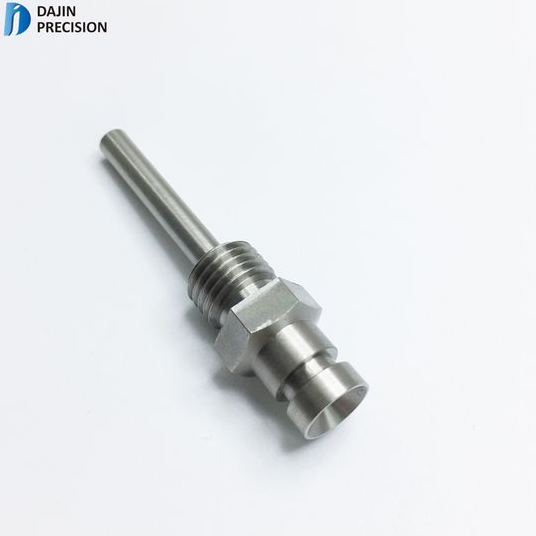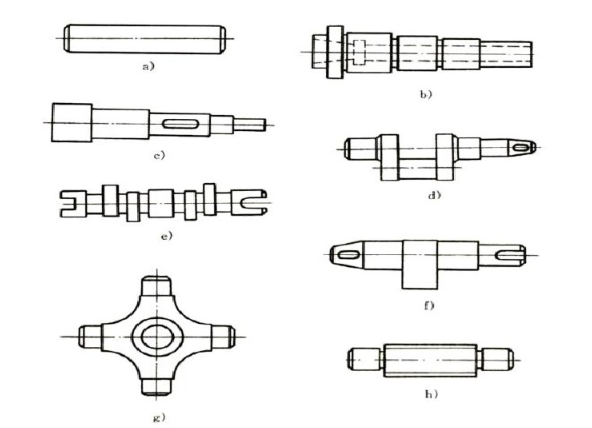Guide to CNC Machining Precision Shafts: Shafts Types, Functions, Processing Route, Turning Problems & Solutions| Dajin Precision
CNC machining shaft is an important component in a range of equipment, Dajinprecision.com is a professional China precision shaft machining company, offering durable and cheap turned shafts. Today, we’ll present shafts definition, functions, types, processing route, as well as problems, causes and solutions in CNC shaft turning.

What are Shafts?
Shafts are one of the most typical machine parts, refers to a rotating element whose length is larger than diameter, the cross section is usually circular, the machined surface generally comes in inner and outer cylindrical surface, conical surface, thread, spline, groove and transverse hole.
What are shafts used for?
Shaft parts are mainly used to support transmission parts, transfer power from one part to another and torque. Gears and pulleys are often mounted on it.
What are the types of shafts?
According to the characteristics of structure and shape, the shafts can be divided into smooth shaft, step shaft, hollow shaft and special-shaped shaft (including crankshaft, camshaft, eccentric shaft and cross shaft). For example, our CNC turning Eccentric Hollow Shaft is both hollow shaft and eccentric shaft.

According to the ratio of length and diameter, the shaft can be divided into rigid shaft (L / d < 15), flexible shaft and slender shaft (L / d > 15).
General Processing Route and Technologies of CNC Machining Shaft
The main surface of precision shaft parts is the outer circle surface. The accuracy requirements for inner hole accuracy of hollow shaft is not very high, while the secondary surface accuracy of thread and spline on precision spindle is required to be high. Therefore, the processing route of shaft parts mainly considers the processing sequence of the outer circle, and reasonably add the machining of the secondary surface. The production and processing route of CNC machining shafts with different accuracy and materials are as below.
1. Shafts made of carburized steel: material preparation -> forging -> normalizing -> drill top hole -> rough turning -> semi-finishing turning, finishing -> carburizing quenching, low temperature tempering -> rough grinding -> secondary surface processing -> fine grinding
2. Shafts made of precision quenched and tempered steel: material preparation -> forging -> normalizing(annealing) -> drill top hole -> rough turning -> quench and temper -> semi-finishing turning, finishing -> surface quenching, tempering -> rough grinding -> secondary surface processing -> fine grinding
3. Precision nitriding steel shaft parts: material preparation -> forging -> normalizing(annealing) -> drill top hole -> rough turning -> quench and temper -> semi-finishing turning, finishing -> low temperature aging -> rough grinding -> nitriding -> secondary surface processing -> fine grinding -> finishing
4. Integrally quenched shaft parts: material preparation -> forging -> normalizing(annealing) -> drill top hole -> rough turning -> quench and temper -> semi-finishing turning, finishing -> secondary surface processing -> integral quenching -> rough grinding -> low temperature aging -> fine grinding
5. General precision shaft parts: apply find grinding as the final process can guarantee the quality
Processing Problems, Reasons and Solutions of CNC Shaft Turning
1. Dimensional accuracy does not meet the requirements
Causes: wrong drawing; improper use of dial; no trial cutting; inaccurate measurement; cutting heat effect; etc.
Solutions: check out the dimensional requirements of the parts drawing clearly; use the dial correctly; carry out trial cutting; check and adjust the zero position, and measure correctly; do not measure when the workpiece temperature is high, use cutting fluid to reduce the temperature.
2. Produce taper
Causes: the turning tool is gradually worn in the middle; the overhang of workpiece is long when it is clamped, and the front end is moved away due to cutting force in turning; when use the chuck to clamp the longitudinal feed in turning, the guide rail of lathe bed is not parallel to the axis of lathe spindle
Solutions: select appropriate cutting tool material or reduce cutting speed; reduce the extension length of workpiece as much as possible, or use the back center support at the other end to increase the clamping rigidity; adjust the parallelism of lathe spindle and lathe guide rail
3. Unqualified roundness
Causes: the clearance of lathe spindle is too large; the blank allowance is not uniform, the back tool feed is too much in the cutting process, etc.
Solutions: check the spindle clearance before turning and adjust it properly. If the main shaft bearing is seriously worn, replace the bearing; conduct fine turning after semi fine turning
4. Unqualified surface roughness
Causes: low rigidity of lathe, vibration caused by unbalanced transmission parts or too loose spindle; unreasonable geometric parameters of turning tool; improper selection of cutting amount, etc.
Solutions: adjust the clearance of each part of the lathe, eliminate or prevent the vibration of the lathe; select reasonable geometric parameters; the feed should not be too large, and the finishing allowance and cutting speed should be appropriate
